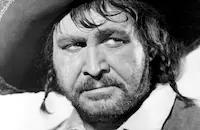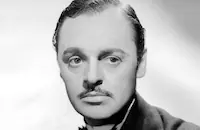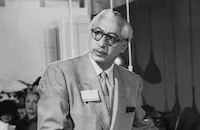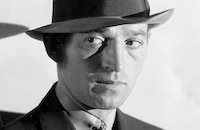Pocketful of Miracles

Brief Synopsis
Cast & Crew
Frank Capra
Glenn Ford
Bette Davis
Hope Lange
Arthur O'connell
Peter Falk
Film Details
Technical Specs

Synopsis
In 1930 New York, shortly after debt-ridden nightclub owner Rudy Martin dies, his daughter Elizabeth, whom he called "Queenie," shows up to hand the deed to his club to kindhearted bootlegger Dave the Dude. Attracted to Queenie, the Dude decides to help her turn the club into a popular speakeasy, and two years later she has paid off all of her father's debts. Everything is going right for the Dude, who thinks that his luck comes from his daily purchase of an apple from "Apple Annie," a disheveled old apple vendor who leads the Broadway panhandlers. He is about to make a deal with Chicago gangster Steve Darcey, and Queenie has agreed to marry him. Just as the Dude is about to close his deal with Darcey, however, his boys are unable to find Annie. Panicky that he won't have the luck he needs for pulling off the Darcey deal, the Dude learns where Annie is from a group of panhandlers who visit his apartment. They tell him that Annie has been supporting a daughter who has been living in a Spanish convent for years and that all of the extra money she has squeezed from them has gone to the girl. In an elaborate deception, Annie has been sending and receiving letters from the girl, named Louise, at the swank Marberry Hotel. When the hotel employee who had been Annie's contact was fired for apparently "stealing" one of the letters, Annie went boldly in and retreived it herself, only to discover that it announced Louise's imminent marriage and arrival in New York with her fianceé and his father, a Spanish count. When the Dude visits Annie, accompanied by Queenie, who has decided to leave the Dude and marry someone else if he closes the Darcey deal, she drunkenly confirms what has happened. Although he is sympathetic, he leaves with his apple, but after the panhandlers offer their meagre savings to finance a real stay for Annie at the Marberry and Queenie goads him into rethinking the matter, the Dude agrees to help. Using a rich friend's appartment at the Marberry, and with the aid of the kindly butler Hutching, the Dude installs Annie as a tenant. With Queenie's help, and that of several hairdressers, makeup artisits and clothiers, Annie is transformed into her elegant society alter ego, Mrs. E Worthington Manville. To complete the picture, Judge Henry Blake, a silver-throated pool hustler, is brought in to play her husband. When the boat arrives that night, the transformed Annie greets Louise, her fiancé Carlos and his father, Count Romero. Reporters on the dock are suspicious when they see the Dude and his gang there and try to get a story, but the Dude's boys Junior and Joy Boy arrange to have the reporters taken away. For the next several days, while the boys try to keep Darcey occupied, Annie and Louise's reunion proceeds joyfully, while the Dude gets swept up in the fairy tale. Despite Joy Boy's constant nagging that Darcey will tire of waiting for a final meeting and turn violent, the Dude cools his heals. Meanwhile, newspaper stories about the missing reporters have surfaced, and the entire city is up-in-arms. From the beat cops to the chief of police, the mayor and even the governor, everyone is being criticized in the press for inaction. As the day of Louise and the Romero's departure approaches, the marriage seems a certainty until Count Romero insists on meeting some of Mrs. Worthington's society freinds. Realizing that the marriage will not go through without some kind of reception, the Dude and Judge Blake tutor his gang on gentlemanly repartee and manners, while Queenie teaches her chours girl freinds how to hehave like "ladies." After intensive coaching, the group seems ready for their debut as society substitutes at the planned reception, but just as they are about to leave Queenie's club, some panhandlers let the Dude know that the police, suspicious that the Dude is involved in the reporters' kidnapping, have surrounded them. As Annie waits in despair and the Count becomes increasingly suspicious because no one has come to the reception, the Dude is questioned by the police commisioner. Unable to explain the situation to the commissioner's satisfaction, the Dude then admits that he has the reporters and promises to kill them unless he is taken to the mayor. While the Dude is being taken to the mayor, who also is having a reception that night, Annie decides that she has no choice but to tell the count the truth. Just as she is about to reveal everything, however, the Dude arrives, accompanied by the mayor, the governor and all of the society guests from the mayor's New Year's Eve reception. As each person greets Annie, they pretend to know her well, which greatly impresses the count. After the reception, limousines drive everyone to the dock to see Louise and the Romeros off. With the reporters safe and no real crimes committed, state and city officials, as well as newspaper editors, decide that no one need ever know the truth. As Annie lovingly waves goodbye to Louise, the Dude tells Queenie that he is going to move to Maryland with her and forget about Darcey, and after the boat pulls away, Annie orders her panhandling friends to get back to work.

Director

Frank Capra
Cast

Glenn Ford

Bette Davis

Hope Lange

Arthur O'connell

Peter Falk

Thomas Mitchell

Edward Everett Horton

Mickey Shaughnessy

David Brian

Sheldon Leonard
Peter Mann

Barton Maclane

John Litel

Jerome Cowan
Jay Novello

Frank Ferguson

Willis Bouchey

Fritz Feld

Ellen Corby

Gavin Gordon

Benny Rubin
Jack Elam

Mike Mazurki
Hayden Rorke
Doodles Weaver
Paul E. Burns
Angelo Rossitto
Edgar Stehli

George E. Stone
William F. Sauls
Tom Fadden
Snub Pollard
Peter Ford
Crew
Roland Anderson
Arthur S. Black Jr.
Robert Bronner
Sammy Cahn
James Cannon
Frank Capra
Nick Castle
Sam Comer
Kenneth Deland
Farciot Edouart
Glenn Ford
Gil Grau
Charles Grenzbach
Hugo Grenzbach
Edith Head
Hal Kanter
Frank P. Keller
Nellie Manley
Ray Moyer
Hal Pereira
Walter Plunkett
Walter Scharf
Joseph Sistrom
Harry Tugend
James Van Heusen
Wally Westmore

Videos
Movie Clip



Trailer
Hosted Intro



Film Details
Technical Specs

Award Nominations
Best Costume Design
Best Costume Design
Best Song
Best Supporting Actor
Articles
Pocketful of Miracles
To make Pocketful of Miracles, actor Glenn Ford's production company Newton combined with Capra's company to form a new entity they called Franton. Ford took the lead role of Dave the Dude and cast Hope Lange, best known for her work in Peyton Place (1957), against type as brassy showgirl Queenie Martin. Helen Hayes was originally set to star in the pivotal role of Apple Annie, but in addition to not being thrilled with the script, Hayes had to pull out of the film due to a State Department tour obligation. Subsequently, the role went to screen legend Bette Davis, who at age 53 had been out of the Hollywood spotlight for some time and needed the work.
Almost immediately there was animosity on the set among the film's three stars, Ford, Davis and Lange, beginning with a remark Ford made to the media implying that he had done Davis a favor by casting her. Years before in 1946 it was Bette Davis who gave newcomer Ford a break to play her love interest in A Stolen Life when she was at the height of her stardom. Davis took great offense at the tactlessness of his remarks, and she complained publicly about Ford's "bad manners and lack of professionalism." Davis's ego took another blow and she almost walked off the film when Ford gave the dressing room he had promised her to Hope Lange, whom he was dating at the time. Star and director were also often at odds with Davis constantly making suggestions to the latter, who had to repeatedly silence her with his amiable reprimand, "Tut, tut, tut, tut!" Capra later suggested that Davis's bad behavior on the set was due to her "inner insecurity and delicate-spirited fears, especially after having been off the screen for so long." In response, a less-forgiving Hope Lange retorted, "Bette Davis is about as delicate-spirited as a tank!"
Ann-Margret, who made her screen debut in Pocketful of Miracles at age 20, recalled a more pleasant experience with Davis in her 1994 autobiography My Story. "It was quite something to be getting my screen baptism playing opposite this movie legend," she wrote. "It would've been intimidating had she not been such a generous, patient teacher! I now know how difficult she was sometimes said to be," she continued, "but to me, she was wonderful." As an example, Ann-Margret described how Davis stopped the action when Capra was filming her first close-up. Davis wanted her own hair and makeup people to work their magic on the redheaded ingenue so she would look her very best.
A big push from the studio hailed the Christmas release of Pocketful of Miracles, followed by many positive reviews. There was special praise for Davis's return to the screen in a fine and often moving performance. Capra, who had suffered such blinding headaches throughout the filming that he hid from the cast and crew, stopped making feature films after Pocketful of Miracles. When asked why, he said simply, "Because I did it all. Now let the younger ones do it." The film's box office profits fell short of expectations, but its warm sentiment won many fans. It garnered Academy Award nominations for Best Costume Design, Best Song, and Best Supporting Actor for Peter Falk, who would gain television fame in the 1970s as eccentric detective Columbo. According to Frank Capra, Falk was the only main actor in Pocketful of Miracles who didn't cause any trouble during the shoot. Capra called him "a joy."
Producer/Director: Frank Capra
Screenplay: Jimmy Cannon, Hal Kanter, Harry Tugend, based on the story, "Madame La Gimp" by Damon Runyon
Art Direction: Roland Anderson, Hal Pereira
Cinematography: Robert J. Bronner
Costume Design: Edith Head, Walter Plunkett
Film Editing: Frank Keller
Original Music: Pyotr Tchaikovsky, Jimmy Van Heusen, Walter Scharf
Principal Cast: Glenn Ford (Dave the Dude), Bette Davis (Apple Annie), Hope Lange (Elizabeth "Queenie" Martin), Arthur O'Connell (Count Alfonso Romero), Peter Falk (Joy Boy), Thomas Mitchell (Judge Blake), Edward Everett Horton (Hutchgins), Mickey Shaughnessy (Junior), Sheldon Leonard (Steve Darcey), Ann-Margret (Louise), Barton MacLane (Police Commissioner).
C-137m. Letterboxed.
by Andrea Forshee

Pocketful of Miracles
Quotes
She's like a cockroach what turned into a butterfly!- Junior
Does it still kinda get you right here?- Joy Boy
What's with her?- Joy Boy
Aah, she just wants a bunch of kids.- Dave the Dude
Kids? Aw, they're mean when they get on that kick.- Joy Boy
Nothing would give me greater pleasure than to be proven an imbecile.- Spanish Consul
Nobody arrives first, sir. They all arrive last.- Butler
Trivia
Director Frank Capra wanted 'Dean Martin' or Frank Sinatra to play Dave, and 'Shirley Jones' for Queenie. After Glenn Ford was cast as Dave, he asked for his girlfriend Hope Lange as Queenie.
Notes
Although copyright records list the color process as Eastman color, HR lists it as Consolidated Color and FD lists it as Technicolor. Pocketful of Miracles, Frank Capra's last feature film, was a remake of his 1933 Lady for a Day, starring Warren William and May Robson (see AFI Catalog of Feature Films, 1931-40). Pocketful of Miracles was the first and only film to be produced by Franton Productions, an independent company co-owned by Frank Capra Productions and Glenn Ford's Newton Productions. A modern source notes that Abe Lastfogel of the William Morris Agency was brought in to settle any disputes that might arise between the two producers, who had equal votes in all matters concerning the picture. As mentioned in his autobiography, Capra disliked this arrangement, which, he believed, gave Lastfogel the power of executive producer. Capra also expressed his displeasure with the United Artists' decision to release the picture with saturation booking in some 200 cities across the country, without first putting it into a first-run engagement in either Los Angeles or New York. However, Capra's recollection of the film's opening was not completely correct. While the film did open on Christmas Day in Los Angeles with the saturation booking, the film had a conventional opening in New York, playing at the Victoria and Trans-Lux 52nd Street theaters only. Pre-release news items indicate that James Cannon, a sports writer whose writing talent was discovered by Damon Runyon, was signed to write the dialogue for the film. According to Capra's autobiography, Cannon did not get a writing credit because of a WGA rule at the time that allowed only two writing credits per screenplay. In an April 1960 NYT interview, Capra mentioned that he wanted either Helen Hayes or Shirley Booth for the role of Apple Annie, and according to subsequent news items in Hollywood Reporter, Hayes made a verbal agreement to play the role in June 1960. According to his autobiography, Capra had also sought Shirley Jones for the role of Queenie. News items also note that Capra sought Tony Franciosa for an unspecified "starring role," and that Edward G. Robinson, Charles Laughton, Fredric March and Burl Ives were all in the running for the role of Judge Henry Blake, which was later assigned to Jack Oakie. When Oakie became ill with a lingering intestinal virus, he was replaced by Thomas Mitchell and his scenes were reshot. Contemporary sources also note that the film, which would cost an estimated 2.5-3 million dollars to produce, marked the screen debut of Ann-Margret, who had been previously set to make her debut in State Fair, a film delayed until 1962. According to a contemporary interview with actress Hope Lange, costumes from Paramount's 1920s and 1930s wardrobe department were deemed too daring for modern censors. A week before Pocketful of Miracles had its Los Angeles release, Los Angeles Times ran ads featuring Richard Nixon endorsing the film. Peter Falk received an Academy Award nomiation for Best Supporting Actor for his role in the picture, which also received a nomination for Best Costume Design (color) and for its title song for Best Song. According to modern sources, Capra wrote the special lyrics for "The Riddle Song," which Ann-Margret sang without musical accompaniment in the film. Modern sources list Frank Capra, Jr. and Ralph Axness as additional assistant directors.

Miscellaneous Notes
Released in United States Winter December 1961
Remake of "Lady For a Day" (1933) directed by Frank Capra. Film debut for Ann-Margret.
Frank Capra's last film.
Released in United States Winter December 1961














